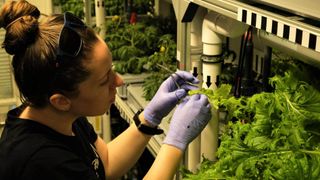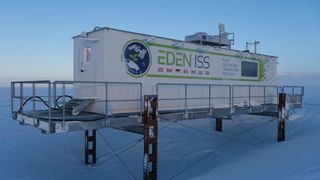Abundant harvest in Antarctic greenhouse shows promise for moon agriculture
A Martian greenhouse in Antarctica produces the best arugula, according to a NASA scientist.

A team of scientists overwintering at a remote station in Antarctica has harvested crops grown in a high-tech greenhouse designed to test technologies that could one day feed explorers on the moon and Mars.
The greenhouse, called EDEN ISS, is run by the German Aerospace Centre (DLR), which cooperates with NASA on space agriculture research. Currently in its fourth season, the greenhouse grows plants aeroponically, which means that the roots of the plants are suspended in air; nutrients and water are delivered in the form of a specially formulated mist, without the presence of soil.
The greenhouse is part of the Neumayer Station III, an Antarctic research station operated by Germany's Alfred Wegener Institute of the Helmholtz Centre for Polar and Marine Research in Bremerhaven.
Every day, NASA botanist Jess Bunchek, one of the 10 crew members of the current 14-month mission, has to venture out 1,300 feet (400 meters) to the 40-foot (12 m) container to check on the crops.
Related: Could space greenhouses solve Earth's food crisis?
During a joint DLR/NASA news conference held on Tuesday (May 4), Bunchek connected right from the greenhouse, admitting that the trek might not always be pleasant. With temperatures plunging as low as minus 58 degrees Fahrenheit (minus 50 degrees Celsius), winds that often match those of a hurricane, and frequent whiteouts, the greenhouse keeper sometimes only has a handrail to guide her to her workplace.
However, Bunchek said, the work pays off: Both eating fresh vegetables and being in the presence of green plants have an enormously uplifting effect on the isolated explorers.
Get the Space.com Newsletter
Breaking space news, the latest updates on rocket launches, skywatching events and more!
"I have been here for a few months and I can say that this is the favorite part of my day. I find that my energy gets lifted up in here," Bunchek reported from the greenhouse. "We don't have a lot of stimulation for the senses: no trees, no greenery. In fact, our day length right now is heavily decreasing. Being here for over a year, we go through a lot of sensory deprivation."

As close to Mars as one can get
DLR chose to locate the experimental module at the Neumayer Station exactly because of the unforgiving environment, which is as close as one can get to lunar or Martian conditions on Earth, Daniel Schubert, EDEN ISS project leader at the DLR Institute of Space Systems in Bremen, said during the same news conference.
The greenhouse features 130 square feet (12 square meters) of growing area, enough to provide the crew with plentiful fresh produce to spice up their diet of long shelf-life food.
"We are implementing three major technologies to cultivate the plants," Schubert said. "We use water-cooled LED lights to provide the light, we spray the plant roots every five minutes with a nutrient solution and we inject carbon dioxide into the atmosphere around the crops and control humidity and temperature."

Flight-ready by 2030
The irrigation and nutrient delivery systems run completely autonomously, Schubert said, allowing Bunchek to focus on her scientific work, which involves studying the nutrient profiles of the crops to help select the best, most nutritious varieties to send to space.
Autonomy is an important requirement for a future greenhouse on the surface of the moon or Mars, as crew members on such missions will not have time for burdensome gardening.
Schubert said DLR is already working on technologies that would further improve the autonomy of the greenhouse as the agency moves towards building an Earth-based lunar greenhouse demonstrator by 2025.
"We are working on the development of a robotic arm that could, with the help of artificial intelligence, harvest cucumbers, treat the plants and cut leaves," Schubert said. "We are also developing big-data applications that would help mitigate risks inside the container."
By 2030, Schubert said, the space agency hopes to have a ready-to-use design for building an actual lunar greenhouse.
A greenhouse on the moon or Mars will have to be part of a closed-loop system that will recycle human waste and carbon dioxide from the atmosphere to provide food and oxygen for the crew. So far, EDEN ISS runs in what Schubert described as a semi-closed loop mode, collecting evaporating water through a dehumidification system.

Best arugula I have ever eaten
Bunchek, who also works on the NASA Vegetable Production System (Veggie), a mini-garden producing fresh greens on the International Space Station, said the plants seem to thrive in the high-tech greenhouse and don't lag behind conventionally grown crops.
"The rucola [arugula] that we harvested has been the best I have ever had," Bunchek said. "Wonderful flavor."
The expedition scientists are already looking forward to the crop of tomatoes, cucumbers, peppers, broccoli and cauliflower.
"There are hundreds of tomatoes forming, although nothing has ripened yet," Bunchek said. "This is also the first time that we have grown broccoli and cauliflower inside the greenhouse, which is very exciting because we didn't expect the cauliflower to put out any heads. We just expected it to be leaves, so that was a really nice surprise."
How to feed a crew on Mars
To fully meet the nutritional needs of a crew on Mars or the moon, such a greenhouse would need an area of 430 to 540 square feet (40 to 50 square meters) per crew member, according to Ray Wheeler, a plant biologist at NASA Kennedy Space Center, who also spoke at the news conference.
Schubert, however, added that the space agencies are looking at what they call hybrid food strategy, which combines freshly grown crops with supplies from Earth.
"We will produce the high water-content crops, like those we have in the EDEN ISS container, directly on site, on the Martian surface," Schubert said. "And we will take stuff like rice, wheat, corn and potato powder with us, because that you can store very easily, you don't have to freeze-dry it and it's very easy to transport."
Wheeler added that some researchers are studying the possibility to add a source of animal-based protein into a future space agriculture facility in the form of insects that would feed on the inedible parts of the harvested plants.
"You could recover some food from this inedible plant material that might be considered waste," Wheeler said. "There are ways of generating and recovering some food using some sort of secondary consumers of the inedible biomass. If you choose the right organisms, you might get high value food. You could also use fungi and mushrooms."
The technology could also be used in the future in urban greenhouses and vertical farms to help boost agricultural productivity across the world, Bunchek added.
Follow Tereza Pultarova on Twitter @TerezaPultarova. Follow us on Twitter @Spacedotcom and on Facebook.
Join our Space Forums to keep talking space on the latest missions, night sky and more! And if you have a news tip, correction or comment, let us know at: community@space.com.

Tereza is a London-based science and technology journalist, aspiring fiction writer and amateur gymnast. Originally from Prague, the Czech Republic, she spent the first seven years of her career working as a reporter, script-writer and presenter for various TV programmes of the Czech Public Service Television. She later took a career break to pursue further education and added a Master's in Science from the International Space University, France, to her Bachelor's in Journalism and Master's in Cultural Anthropology from Prague's Charles University. She worked as a reporter at the Engineering and Technology magazine, freelanced for a range of publications including Live Science, Space.com, Professional Engineering, Via Satellite and Space News and served as a maternity cover science editor at the European Space Agency.
